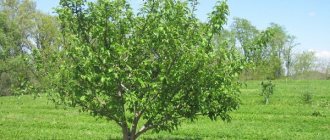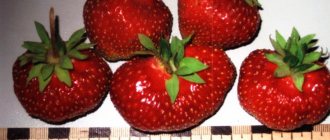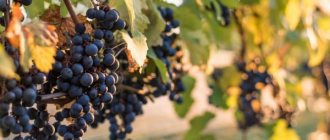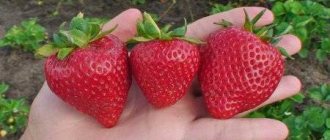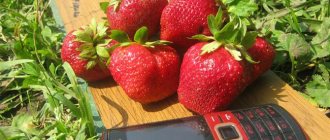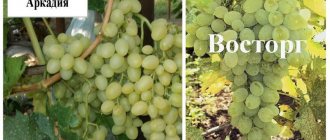Strawberries are one of our favorite treats. We always look forward to her maturation. In our garden plot, we strive to grow only the best productive varieties of this garden berry, which would delight us with their advantages and have a minimum of disadvantages.
Florence's garden strawberry is an aristocrat by origin, characterized not only by its stunning aroma and taste, but also by persistent immunity to almost all known ailments and good winter hardiness, which allows the hybrid to be cultivated over a wide area.
Photo of Florence's strawberries.
Description of the variety and its characteristics
Florence is an elite type of garden strawberry, originating in distant England. It was released in 1997. The parent varieties are Vima-Tarda and Vikoda.
English breeders set out to create a hybrid that, with an excellent taste of berries and abundant harvests, would have good resistance to fungal diseases and insect pests, and would also thrive in harsh frosty winters. The scientists' work was crowned with success - Florence's strawberries fully met their hopes.
Description of plants
The aristocratic bushes are large, tall, powerful and very beautiful. They will not only give a rich harvest, but will also serve as a wonderful decoration for any country house:
- plants are not very spreading, voluminous with tall, strong, erect peduncles, which often fall to the ground from the weight of the harvest;
- leaves, large, shiny, dark green, form rosettes;
- the bushes produce a small number of tendrils, but they are enough to propagate strawberries;
- The flowers are large and white. Each peduncle contains 5-7 flowers;
- Pollination of Florence does not require additional pollinators - the plants have flowers of both sexes;
- flowering begins in late May-early June and lasts 2 weeks;
- Bushes bear fruit for 3-4 years, and then they need to be renewed.
Description of fruits
Florence's berries, beautiful and shiny, grow in medium to large sizes:
- the weight of one fruit can vary from 40 to 70 g;
- The shape of the berries is a regular cone. There are fruits of round shape;
- The color of the fruit is bright red. The seeds have the same color;
- The pulp is scarlet - dense and very juicy. Characterized by a pronounced strawberry aroma;
- the taste of the fruit is rich, sweet, with some sourness.
The berries of this variety contain a large amount of sugars. Moreover, unfavorable weather does not affect the concentration of sugar in fruits.
Usage
The hybrid berries have a great taste. Both adults and children love to enjoy them fresh. The fruits make unusually aromatic jam and confiture. They are also rubbed with sugar, frozen, prepared in various desserts, used as a filling, and added to various confectionery products and gourmet fruit salads.
Ripening and harvesting dates
Florence is considered a late-ripening variety. Its fruits begin to ripen when other types of crops have already borne fruit. The first berries appear in early July. Mass ripening of berries occurs in the middle of the month. The plants finish bearing fruit by mid-August. Berries are collected as they ripen.
Productivity
Strawberries of this type are very productive. One plant produces from 400 to 700 g of juicy, aromatic fruits. With high-quality care for the bushes, you can get 2 times more berries. Under conditions of mass cultivation, about 300 centners are harvested from one hectare.
Shelf life and transportability
Due to the fact that Florence fruits have a dense consistency, they can be stored in the refrigerator for 5-7 days without losing their taste and presentation.
Thanks to this, the berries of this hybrid tolerate transportation well, and therefore are popular among farms that cultivate this type of garden strawberry on a commercial scale.
Harvest and storage
The crop is harvested as it ripens. The berries are picked together with the stalks - this way they will retain their freshness longer. Immediately during harvesting, the harvest is sorted and mechanically damaged specimens are rejected.
You will be interested to know about fertilizing strawberries after harvest.
More ripe berries are left for quick consumption; those that are not yet fully ripe are placed in low boxes lined with paper in one layer. Store in a place inaccessible to sunlight, at a temperature from 0 to +6 ° C and a humidity of 70%. Under such conditions, the berries are kept fresh for 7–10 days.
Strawberries of the Florence variety are a universal crop with high adaptive abilities. It takes root well in any climate and is suitable for growing in small quantities for personal use and production on an industrial scale.
Climate and growing regions
The variety has fairly good frost resistance. It can withstand frosts down to -25 °C. The plants tolerate both high humidity and hot summer weather, so Florence can be cultivated over a wide area.
Strawberries of this type are grown in the Southern regions, in the Central regions, in the Volga region, in the Middle Zone, in the North-West and even in Siberia (under film cover).
The best place for Florence strawberries
Strawberries should be planted in open, sunny areas located in the south. When planted in shady places, the bushes stretch out and reduce productivity.
Berries are formed only in an area protected from strong gusts of wind, since drafts provoke rotting of the tender roots.
The variety prefers light, fertile, loose soils with a high content of nutrients. These are sandy loams, loams, chernozems.
"Florence" is not planted in areas where groundwater occurs.
Unwanted Precursors:
- tomatoes;
- potato;
- raspberries;
- eggplants.
The best neighbors for strawberries are greens, lettuce, carrots, and radishes.
Diseases and pests
Florence is resistant to major fungal diseases and pests, but the possibility of plant damage cannot be ruled out:
- gray mold, which will be protected by treating the bushes with Alirin-B and Switch fungicides, as well as spring spraying of plants with a 1% solution of Bordeaux mixture (per 10 liters of water - 100 g of copper sulfate and 150 g of lime);
- powdery mildew. Treating strawberries with Topaz, Kuproxat or Horus fungicides will help prevent the disease. At the first symptoms, the bushes are treated with colloidal sulfur or the drugs Euparen, Karatan, Plondrel;
- brown or white spotting, which can be dealt with by Ridomil, Falcon, Skor or Metaxil. Treatment of plants with these preparations is carried out in early spring;
- verticillium. The problem will be solved by fungicides Fitosporin, Maxim, Fitodoctor, Fundazol. These remedies are used at the first signs of illness. The best prevention against the disease is high-quality crop care.
Powdery mildew on strawberries.
Florence almost never suffers from pest attacks. The exception is slugs, from which the drug Karbofos will protect strawberries.
Advantages and disadvantages
The hybrid is characterized by many advantages:
- good winter hardiness and drought resistance;
- high quality fruits;
- abundant harvests;
- excellent immunity to diseases and pests;
- resistance to adverse weather conditions;
- late ripening;
- possibility of transportation.
The disadvantages include:
- tendency to fungal diseases in damp and cloudy weather;
- increased demands on fertilizing and watering.
Reproduction
You can propagate Florence strawberries:
- seeds;
- mustache;
- sockets.
Propagation by seeds
The seed propagation method is the most labor-intensive. It is used quite rarely. You can buy seeds in the store, or you can prepare them yourself. To do this, select the largest and ripest berry, cut off the top layer with seeds and put it on cheesecloth to dry.
After a few days, the contents of the gauze are ground, the seeds are selected and stored. Before planting, the seeds are taken out and soaked for several days in melt water, and then for several hours in a growth stimulator. Next, the seed is dried and sown in previously prepared soil.
Reproduction by mustache
This method is the most popular. They choose the largest and healthiest bush, in the spring they remove all flower stalks from it, and as soon as mustaches with rosettes appear, they begin to intensively care for them. As soon as the rosette takes root and a growing point appears on it, the tendrils are separated from the mother plant and planted in open ground.
Reproduction by dividing the bush
To do this, take a large perennial bush and divide it so that each part has a root system and a rosette with a growing point.
Landing
Florence strawberry planting algorithm:
- choose a place for the garden bed that is light and dry with loose fertile soil;
- the site is dug up in advance, cleared of roots and weeds, fertilized and beds formed;
- then make holes, the distance between which should be 35-40 cm, add a handful of fertile soil mixed with mineral and organic fertilizers into each hole, and place the seedlings in them, straightening the roots;
- The holes are filled in, the soil is compacted, watered and mulched.
Care
There is nothing difficult in caring for Florence:
- Plants of this variety love moisture very much, so they need to be watered generously periodically. If you don’t do this, the berry will grow small;
- The hybrid responds well to feeding. In the spring, strawberries need nitrogen-containing fertilizer, before flowering begins - phosphorus and potassium fertilizers, and in the fall they add organic matter;
- The soil around the bushes is kept clean, weeds are selected and organic debris is removed. This is done to avoid illness;
- with the help of loosening, they provide oxygen access to the roots;
- Before wintering, cut off the entire above-ground part of the strawberry, leaving only a few centimeters, and cover it if necessary.
Reviews
- Mikhail: “I got “Florence” relatively recently, so I haven’t yet formed a clear opinion about this variety. On the one hand, I am very pleased with its productivity and the excellent taste of the berries. On the other hand, I am a supporter of more undemanding varieties, because there is neither the strength nor the opportunity to spend all the time at the dacha. “Florence” is capricious in this regard, because without fertilizing the berries become noticeably smaller and sour in taste. In general, if you approach this matter responsibly, you can quickly recoup all costs. In the near future I want to organize a greenhouse shelter and try this growing method.”
- Tatiana: “I purchased strawberries “Florence” at the exhibition, and only five seedlings. The owner assured that it could be propagated without problems in literally a year. It didn’t work out that way for me, and besides, three sprouts simply didn’t take root—already at home I discovered that the roots were almost completely dry. The remaining two specimens were planted for a trial period, but grew surprisingly well and began to actively displace other varieties. “Florence” is my favorite right now, right after the early “Olivia.” The taste of the berries is very difficult to describe, because it contains not only sweetness, but also a distinct sourness. Oddly enough, this is what makes it unforgettable, in my opinion, it is one of the most unusual strawberries I have tried.”
Reviews from gardeners about Florence strawberries
Despite some difficulties in growing Florence, that is, its demands on watering and fertilizing, gardeners fell in love with this garden berry for its unique taste and beautiful appearance of the fruit.
Raisa, 55 years old
“I purchased several Florence seedlings, but only three took root. They grew very quickly and produced a harvest the very next year. The taste of the berries is very difficult to describe. He is quite unusual, I have never seen anything like this before. I was also struck by the rich strawberry aroma.”
Kirill, 46 years old
“The variety is too capricious. It requires constant abundant watering and frequent feeding. But it's worth it. For the sake of amazing taste and bright aroma, you will do anything, you will close your eyes to all difficulties. I will continue to grow.”
How and when to plant berries
The English aristocrat is surprisingly very undemanding about the composition of the soil. It takes root well on sandy and loamy soils, but when the proper amount of humus is added, it is quite capable of producing a good harvest on clay soil. It is better to purchase young plants in separate containers. Such seedlings with a closed root system will better take root and adapt to new growing conditions.
But what the Bereginya variety looks like in the photo, and what features of its cultivation exist, are indicated here.
It’s also worth looking at what the Chamora Turusi variety looks like in the photo: //gidfermer.com/sadovodstvo/yagody/klubnika-chamora-turusi.html
Important planting steps:
- The optimal time for planting is early September. The seedlings adapt well and will produce a full harvest in the spring. If planting is carried out in the spring, it is necessary to consider reliable shelter in case of night frosts.
- Before planting, the soil must be dug well and, if necessary, fertilizing and organic matter must be used. It is better if the soil stands for a little (literally a couple of days) so that the roots of the plants quickly take root in the new place.
- The seedlings are placed with sufficient space between the bushes, because the plant is distinguished by its rather large dimensions. And here is what the Sonata variety seedlings look like.
- When planting, it is necessary to leave the root collar flush with the ground, without deepening it.
- From above, the soil around the roots is mulched and well watered.
Video shows how to grow seedlings from seeds:
After such planting, the next feeding will be needed no earlier than two to three months later. If the plant is planted in winter, abundant watering at the end of the season is considered mandatory. This will help the strawberries survive this period without damage to the root system, because moisture will provide a sufficient “margin of safety” for problem-free adaptation. Read about the description of the Black Prince strawberry variety here.

